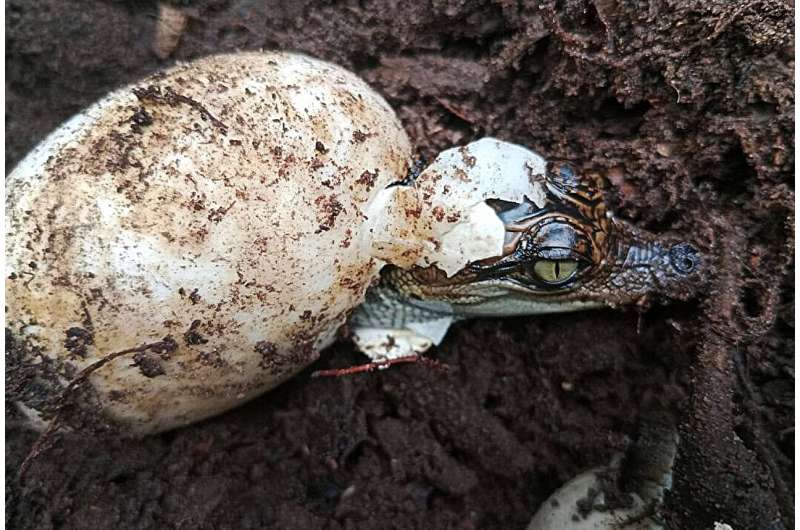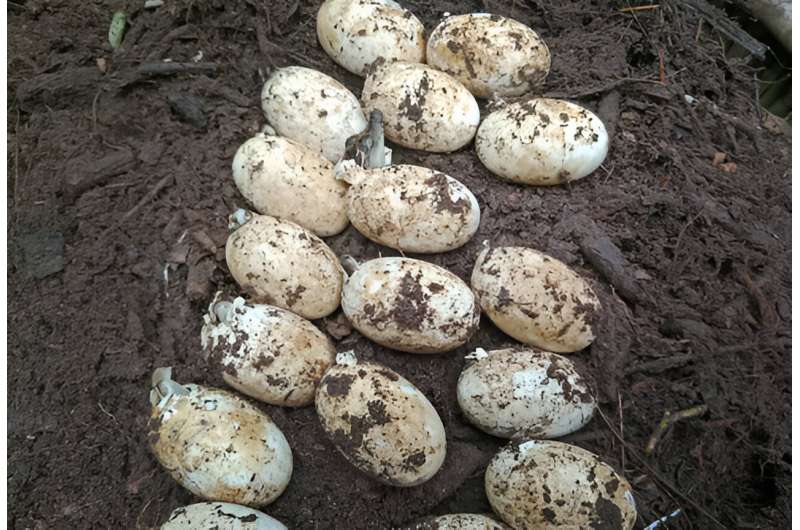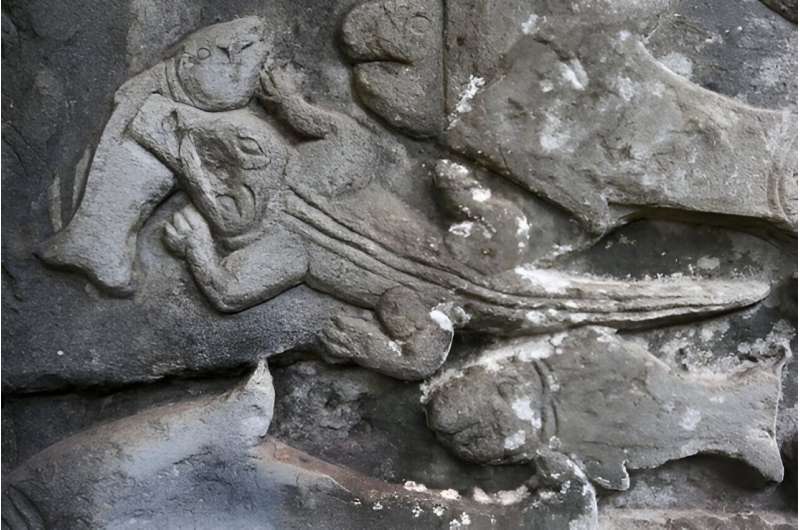This article has been reviewed according to Science X's editorial process and policies. Editors have highlighted the following attributes while ensuring the content's credibility:
fact-checked
trusted source
proofread
New hope for critically endangered Siamese crocodile

Sixty Siamese crocodiles, from five separate nests, have successfully hatched in Cambodia's Cardamom National Park—the largest record of this species breeding in the wild this century and a massive boost for the survival prospects of this critically endangered reptile.
Crocodiles tend to be given a bad press. But that notoriety does at least bring these much-maligned and misunderstood animals into the public consciousness. From alligators in the Everglades to Australia's saltwater crocs and the wildebeest-grabbing Nile crocs, stories abound of narrow escapes from man-eating monsters.
Spare a thought for the Siamese crocodile. This little-known, unheralded reptile is neither monstrous nor man-eating. And in this case, the only noteworthy narrow escape has been on the part of the crocodile itself, from the jaws of extinction.
Once widespread in the wetlands of Southeast Asia, it has disappeared from 99% of its former range. The Siamese crocodile was feared to be extinct in the wild until a Fauna & Flora-led survey team rediscovered it in Cambodia's Cardamom Mountains.
Community-led conservation of Siamese crocodiles
It's no accident that the Siamese crocodiles in this remote region escaped the fate of so many of their kind. The local Indigenous People revere this reptile, and it is taboo to kill or hurt one. Unfortunately, the Siamese crocodile hasn't always been afforded that level of care in the wider world. Decades of hunting and habitat loss decimated the wild populations. It is one of the world's rarest reptiles and remains in urgent need of conservation attention.
The people who have always lived harmoniously alongside Siamese crocs are the ones best placed to protect them. For well over two decades, Fauna & Flora has worked closely with these local communities and the Cambodian government to safeguard—and supplement—the remaining crocodile population.
Community-led monitoring and anti-poaching activities are helping to protect key breeding sites, and we're working with the Cambodian government to bolster the surviving wild crocodile population through a conservation-breeding and reintroduction program. Since 2012, the program has successfully released a total of 196 captive-bred Siamese crocodiles in safe areas and suitable habitats in the Cardamom Mountains.
And now we have further proof that our joint efforts are having a real impact on a species that was once in grave danger of sliding unnoticed into extinction.
Eggs in five baskets
In May 2024, a group of people living locally to the Cardamom Mountains discovered three nests in an area where captive-bred crocodiles have never been released before—suggesting that this is a key natural habitat for the species and that long-term protection efforts are allowing these wild populations to start bouncing back.

The local crocodile discoverers immediately reported the nests to Fauna & Flora's Cambodian conservation team and the local community wardens, who mobilized to ensure the nests were protected around the clock. Just days later excitement heightened as two further nests were found in another area of Cardamom National Park.
At the end of June, a total of 60 Siamese crocodile hatchlings successfully emerged from these nests, an incredible result for conservationists and a real sign of hope for the future of this species.
Conserving crocs collaboratively
Pablo Sinovas, Country Director, Fauna & Flora Cambodia Program, comments, "For over a decade, Fauna & Flora, alongside our dedicated partners, has been steadfast in our mission to bolster Siamese crocodile populations in Cambodia's Cardamom Mountains. This involves not only breeding them in captivity but also ensuring they have a suitable habitat to be released into. Strengthening protection of key sites within Cardamom National Park is crucial, shielding these habitats from threats such as deforestation and poaching.
"The recent discovery of wild nests emphasizes the vital importance of safeguarding this area. With only a few hundred individuals estimated in the wild, the hatching of 60 new crocodiles is a tremendous boost. At a time when wetland biodiversity is declining rapidly across the region, it underscores the potential for natural recovery through sustained collaborative conservation efforts."

Toy Chorn, a community warden who helped discover and protect the nests, comments, "We have been working closely with Fauna & Flora to protect this critically endangered species for several years, and we were excited to have found these crocodile nests. This discovery indicates that our conservation efforts have paid off, and I believe that with our ongoing conservation efforts, the population of Siamese crocodiles will continue to increase in the future."
Dr. Eang Sophalleth, Cambodia's Minister of Environment, said, "One of the goals of the Circular Strategy on Environment is biodiversity protection and conservation. The Siamese crocodiles play an important role in the ecosystem, and the discovery of five nests with successful hatching of 60 eggs reflects that the Cardamom National Park is a safe and suitable natural habitat for this species."
"It is a source of pride that Cambodia has the world's rarest species, especially in the Cardamom National Park and other protected areas. We will continue our efforts to conserve biodiversity for the benefit of the nation and our next generations."
Dith Tina, Minister of Agriculture, Forestry and Fisheries, also adds, "This is a significant achievement in the Endangered Species Conservation Program. Collaborating with NGO partners, the Ministry of Environment, and subnational administrations, we've worked to promote the growth of rare species like Siamese crocodiles, dolphins and royal turtles. The Forestry Administration of the Ministry of Agriculture, Forestry and Fisheries, in collaboration with Fauna & Flora Cambodia, has made substantial efforts to breed pure Siamese crocodiles and release them back into the wild within conservation areas.
"This successful endeavor demonstrates the positive impact of our collective work, as Siamese crocodiles now reproduce independently, forming new nests and offspring in their natural habitat. It reinforces our commitment to conserve Cambodia's diverse biodiversity for generations to come."
Provided by Fauna & Flora



















